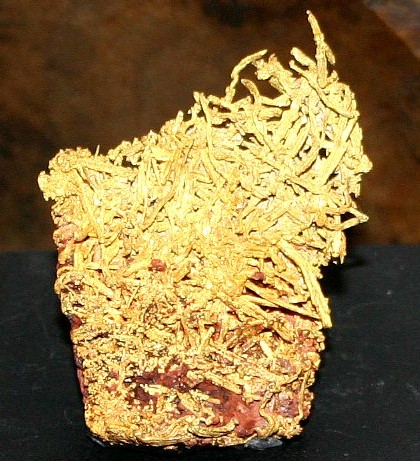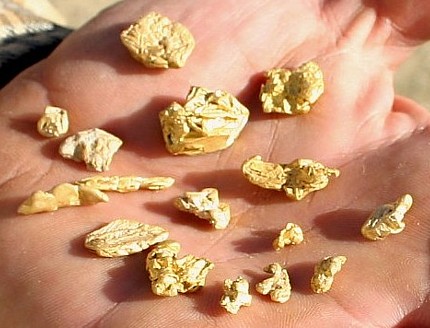GOLD is a name to charm by. It is desired by all nations, and is the one metal the supply of which never exceeds the demand. It has been said, "Gold is the most potent substance on the .surface of our planet. It has been repeatedly asserted that the deposits in the sands of the beaches of Behring Sea, in the vicinity of Cape Nome, are unique; when, in reality, mining operations similar to those carried on at Nome last summer, have been carried on since the world began. It is astonishing how little the average man of business knows of gold. That this much appreciated metal is heavy to get is proved by the high value which has been placed on it from times remote to date, and that it is light to hold most of us know to our cost.
We read no farther than the second chapter in the Bible when we find mention of gold. There Moses speaks of " the land of Havilah, where there is gold;" and in Genesis, Chapter XXIV, we read that Abraham's servants gave Rebekah an earring of half a shekel weight, say 4 dwt. 13 grains., and two "bracelets of ten shekels weight", or about 4 ounces. Throughout the Scriptures, and, indeed, in all historic writings, we find frequent mention of the king of metals, and always it is spoken of as a commodity highly prized. Either we are mistaken in the weights used by the Hebrew nation in early days, or the arithmetic of those times was not quite "according to Cocker". We read, I. Kings X and XLI, that Solomon in one year received no less than six hundred and three score and six talents of gold. If a talent of gold was, as has been assumed, 3,000 shekels of 219 grains, the value of the golden treasure accumulated in this one year by the Hebrew king would have been 3,646,350 sterling. Considering that the only means of "getting gold" in those days was a most primitive mode of washing it from river sands, or a still more difiicult and laborious process of breaking the quartz from the lode without proper tools or explosives, and then slowly grinding it by hand labor between two stones, the amount mentioned is truly enormous.
Of this treasure the Queen of Sheba, who came to visit the Hebrew monarch, contributed a hundred and twenty talents, or, say, $3,000,000 worth. Where the land of Ophir, whence this golden lady came, was really situated has evoked much controversy, but there is now a general opinion that Ophir was on the east coast of Africa, somewhere near Delagoa Bay, in the neighborhood of the Limpopo and Sabia Rivers. It should be mentioned that the name of the "black and comely" queen was Sabia, which may or may not be a coincidence, but it is certainly true that the rivers of this district have produced gold from prehistoric times till now. The discovery of remarkable ruins in Mashonaland, which evince a high state of civilization in the builders, may throw some light on this interesting subject. The principle value of gold is as a medium of exchange, and its high appreciation is due, first, to the fact that it is in almost universal request ; and, secondly, to its comparative scarcity; yet, oddly enough, with the exception of that humble but serviceable metal, iron, gold is the most widely distributed metal known. Few, if any, countries, do not possess it, and in most parts of the world, civilized and uncivilized, it is mined for and brought to market. The torrid, temperate and frigid zones are almost equally - auriferous. Siberia, mid-Asia, most parts of Europe, down to equatorial and Southern Africa in the Old World, and North, Central and Southern America, with Australasia, in what may be termed the New World, are all producers of gold in payable quantities.
In the earlier ages, the principle source of the precious metal was probably Africa, which has always been prolific in gold. To this day there are to be seen, in the southern provinces of Egypt, excavations and the remains of old mine buildings and appliances left by the ancient gold-miners, who were mostly state prisoners. Some of these mines were worked by the Pharaohs of, and before, the time of Moses; and in these dreadful places thousands of Israelites were driven to death by the taskmaster's whip. The first mode of obtaining this much desired metal was, doubtless, by washing the sand of rivers which flowed through auriferous strata. Some of these, such as the Eydian Stream, Pactolus, were supposed to renew their golden stores miraculously each year. What really happened was that the winter floods detached portions of auriferous drift from the banks, which, being disintegrated by the rush and flow of the water, would naturally deposit in the still reaches and eddies any gold that "might be contained therein. The mode of washing was exactly that carried on by the natives in some districts of Africa to-day. A wooden bowl was partly filled with auriferous sand and mud, and, standing knee-deep in the stream, the operator added a little water, and caused the contents of the bowl to take a circular motion, somewhat as the modern digger does with his tin dish, with this difference, that his ancient prototype allowed the water and lighter particles to escape over the rim as he swirled the stuff round and round. I presume, in finishing the operation, he collected the golden grains by gently lapping the water over the reduced material, much as we do now.
Gold differs in its mode of occurrence from other metals in many respects; but there is no doubt that it was once held in acqueous solution and deposited in its metallic form by electro-chemical action. It is true we do not find oxides, carbonates, or bromides of gold in nature, nor can we feel quite sure that gold now exists naturally as a sulfide, chloride, or silicate, though the presumption is strongly that it does. If so, the deposition of gold may be ceaselessly progressing. It is well known that much disappointment and loss accrue through lack of knowledge by prospectors, who, with all their enterprise and energy, are often very ignorant, not only of the probable locality, mode of occurrence, and widely differing appearance of the various minerals, but also of the best means of locating and testing the ores when found. All of us who have had much to do with mining know that the majority of the best mineral finds have been made by the purest accident; often by men who had no mining knowledge whatever ; and that many valuable discoveries have been delayed, or when made, abandoned as not payable, from the same cause: ignorance of the rudiments of mineralogy and mining.
Old river beds, formed of gravelly drifts in the same neighborhood, may probably contain alluvial gold ; or shallow deposits of "wash" on hillsides and in valleys, will often carry good surface gold. This is sometimes due to the denudation, or wearing away of the hills containing quartz veins, which, popular opinion to the contrary', is not always the case. Much disappointment and loss of time and money may sometimes be prevented if prospectors will realize that all alluvial gold does not come from the quartz veins or reefs; and that following up an alluvial lead, no matter how rich, will not inevitably develop a payable gold lode. Sometimes gold, evidently of reef origin, is found in the alluvial; but in that case it is generally fine as regards the size of the particles, more or less sharp-edged, or crystalline in form if recently shed; while such gold is often of poorer quality than the true alluvial which occurs in mammillary nuggets, it is of a far higher degree of purity as gold.
The ordinary non-.scientist digger will do well to give credence to this view of the case, and will often thereby save himself much useless trouble. Sometimes also the alluvial gold, coarser in .size than true reef-born alluvial, is derived almost in situ from small quartz "leaders", or veins, which the grinding down of the surface of the .slates has exposed; these leaders also in time being broken and worn, set free the gold they have contained ; this does not, as a rule, travel far ; but sometimes becomes water-worn by the rubbing over it of the disintegrated fragments of the rock.But the heavy, true alluvial gold, in great pure masses, mammillary or botryoidal (like a bunch of grapes) in shape, have assuredly been formed by accretion of some metallic base from gold salts in solution, probably choride, but possibly sulfide. Prospecting for alluvial gold at shallow depths is a comparatively easy process, requiring no great amount of technical knowledge. Usually the first gold is got at or near the surface, and then traced to deep leads, if such exist.
Return To:
Gold and Silver Prospecting Basics


